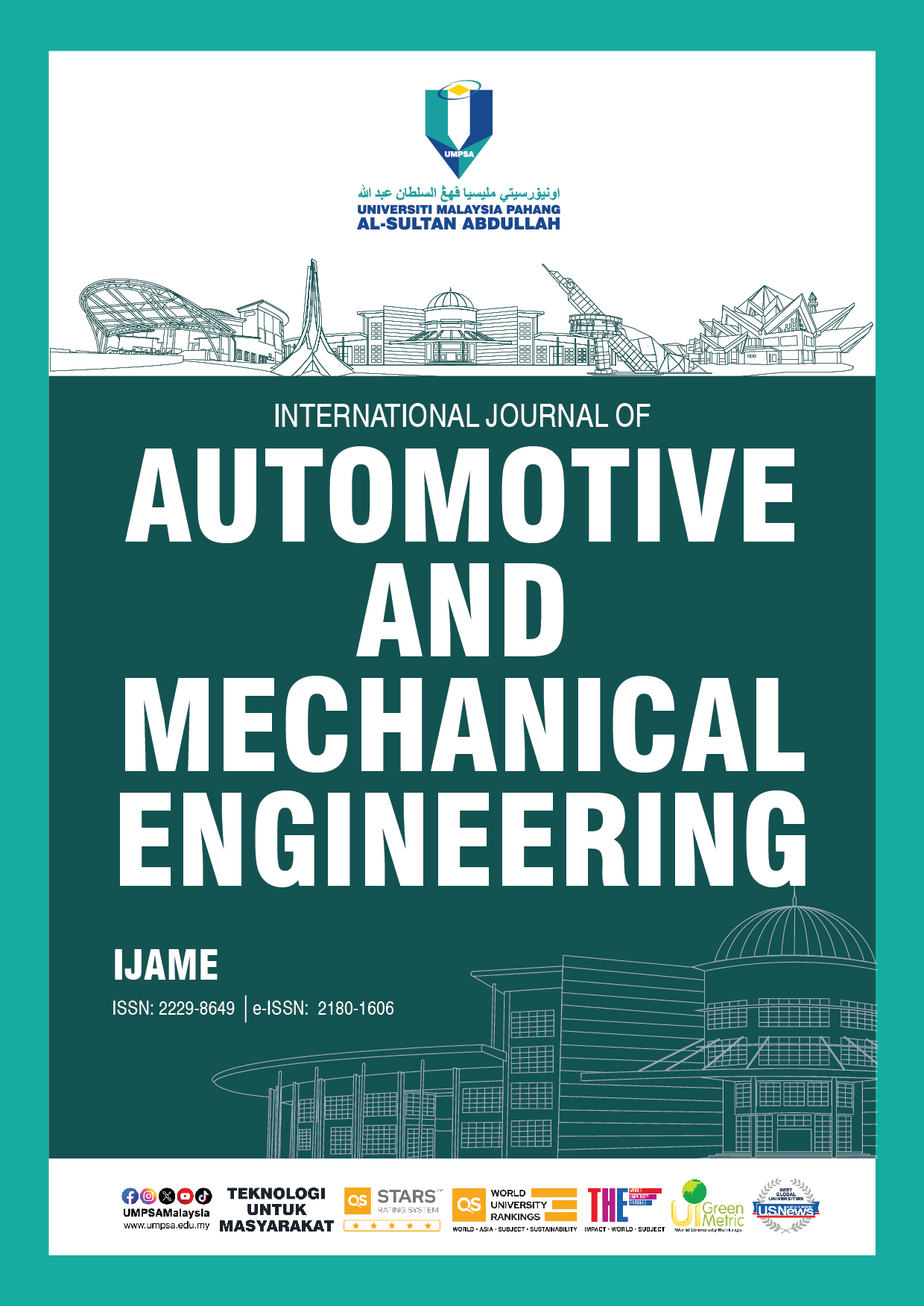Analysis of a Simplified Predictive Function Control Formulation Using First Order Transfer Function for Adaptive Cruise Control
DOI:
https://doi.org/10.15282/ijame.21.3.2024.15.0898Keywords:
Adaptive cruise control, Safe distancing, Inverse model, Model predictive controlAbstract
This paper presents a formulation and analysis of a low computation Predictive Functional Control (PFC), which is a simplified version of the more advanced Model Predictive Control (MPC) for an Adaptive Cruise Control (ACC) system by using a representation of first order closed-loop transfer function. In this work, a non-linear mathematical model of vehicle longitudinal dynamics is considered as a control plant. Then, a simple Proportional Integral (PI) controller is employed as an inner loop to identify the first-order relationship between its actual and desired trajectory speed according to the reasonable time constant based on the logical response of pedals pressing. To directly control the whole plant, the PFC is formulated as an outer loop to track the desired speed together with the convergence rate based on a user preference while satisfying constraints related to acceleration and safe distancing. Since PFC is formulated based on the first-order transfer function, the prediction and tuning processes are straightforward and specific to this system. The simulation results confirm that the proposed controller managed to track the desired speed while maintaining a comfortable driving response. Besides, the controller also can retain safe distancing during the car following application, even in the presence of unmeasured disturbance. In summary, this framework can avoid the need to formulate an inverse non-linear model that is typically used when deploying a hierarchical control structure to compute the throttle and brake pedals pressing as it has been replaced with an inner loop PI controller. The performance also is comparable yet more conservative due to the simplification. These findings can become a good reference for designing and improving the ACC controller, as the framework can be easily generalized for any type of vehicle for future work.
References
Y. Lin, J. McPhee, and N.L. Azad, “Comparison of deep reinforcement learning and model predictive control for adaptive cruise control,” IEEE Transactions on Intelligent Vehicles, vol. 6, no. 2, pp. 221-231, 2020.
S. Liu, L. Liu, J. Tang, B. Yu, Y. Wang, and W. Shi, “Edge computing for autonomous driving: Opportunities and challenges,” Proceedings of the IEEE, vol. 107, no. 8, pp. 1697-1716, 2019.
S. Chaturvedi and N. Kumar, “Design and implementation of an optimized PID controller for the adaptive cruise control system,” IETE Journal of Research, vol. 69, no. 10, pp.7084-7091, 2023.
S. Chamraz and R. Balogh, “Two approaches to the adaptive cruise control (acc) design,” in 2018 Cybernetics & Informatics (K&I), IEEE, pp. 1-6, 2018.
M. Zainuddin, M. Abdullah, S. Ahmad and K. Tofrowaih, “Performance comparison between predictive functional control and pid algorithms for automobile cruise control system,” International Journal of Automotive and Mechanical Engineering, vol. 19, no. 1, pp. 9460-9468, 2022.
P. Shakouri, A. Ordys, D.S. Laila and M. Askari, “Adaptive cruise control system: Comparing gain scheduling PI and LQ controllers,” IFAC Proceedings, vol. 44, no. 1, pp. 12964-12969, 2011.
G. Prabhakar, S. Selvaperumal and P.N. Pugazhenthi, “Fuzzy PD plus I control-based adaptive cruise control system in simulation and real-time environment,” IETE Journal of Research, vol. 65, no. 1, pp. 69-79, 2019.
F. Islam, M.M. Nabi, M.M. Farhad, P. Peranich, J.E. Ball, and C. Goodin, “Evaluating performance of extended Kalman filter based adaptive cruise control using PID controller,” in Autonomous Systems: Sensors, Processing, and Security for Vehicles and Infrastructure 2021, SPIE, vol. 11748, pp. 46-56, 2021.
A. Laith, E. Serdar, I. Davut and Z.R. Abu, “Modified elite opposition-based artificial hummingbird algorithm for designing for PID controlled cruise control system,” Intelligent Automation & Soft Computing, vol 38, no. 2, 169-183, 2023.
N.C. Basjaruddin, K. Kuspriyanto, D. Saefudin and I.K. Nugraha, “Developing adaptive cruise control based on fuzzy logic using hardware simulation,” International Journal of Electrical and Computer Engineering, vol. 4, no. 6, p. 944, 2014.
P. Mahadika, A. Subiantoro and B. Kusumoputro, “Neural network predictive control approach design for adaptive cruise control,” International Journal of Technology, vol. 11, p. 1451, 2020.
Y.C. Lin and H.L.T. Nguyen, “Adaptive neuro fuzzy predictor-based control for cooperative adaptive cruise control system,” IEEE Transactions on Intelligent Transportation Systems, vol. 21, no. 3, pp. 1054-1063, 2019.
R. Zhao, P.K. Wong, Z. Xie and J. Zhao, “Real-time weighted multi-objective model predictive controller for adaptive cruise control systems,” International Journal of Automotive Technology, vol. 18, pp. 279-292, 2017.
T. Takahama and D. Akasaka, “Model predictive control approach to design practical adaptive cruise control for traffic jam,” International Journal of Automotive Engineering, vol. 9, no. 3, pp. 99-104, 2018.
A. Weißmann, D. G¨orges and X. Lin, “Energy-optimal adaptive cruise control based on model predictive control,” IFAC-PapersOnLine, vol. 50, no. 1, pp. 12563-12568, 2017.
U. Karapınar and L. G¨oren-S¨umer, “Laguerre MPC formulation for automotive adaptive cruise control application and performance analysis,” in 2018 6th International Conference on Control Engineering & Information Technology, pp. 1-6, 2018.
M.A.S. Zainuddin, M. Abdullah, S. Ahmad, M.S. Uzir and Z.M.P.A. Baidowi, “Performance analysis of predictive functional control for automobile adaptive cruise control system,” IIUM Engineering Journal, vol. 24, no. 1, pp. 213-225, 2021.
J.A. Rossiter and M. Abdullah, “A new paradigm for predictive functional control to enable more consistent tuning,” in 2019 American Control Conference, pp. 366-371, 2019.
M. Abdullah and J.A. Rossiter, “Using laguerre functions to improve the tuning and performance of predictive functional control,” International Journal of Control, vol. 94, no. 1, pp. 202-214, 2021.
S. Idros, M. Abdullah, S.F. Toha, and M.S. Md Said, “Modelling of vehicle longitudinal dynamics for speed control,” Journal of Advance Research in Applied Mechanics, vol. 123, no. 1, pp. 56-74, 2024.
J. Richalet and D. O'Donovan, Predictive functional control: Principles and industrial applications. Springer Science & Business Media, 2009.
R. Rajamani and R. Rajamani, “Longitudinal vehicle dynamics,” in Vehicle Dynamics and Control. Mechanical Engineering Series. Springer, Boston, pp. 87-111, 2012.
Downloads
Published
How to Cite
Issue
Section
License
Copyright (c) 2024 The Author(s)

This work is licensed under a Creative Commons Attribution-NonCommercial 4.0 International License.







